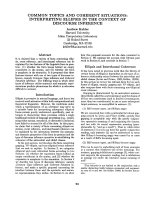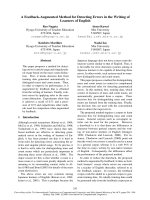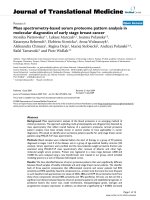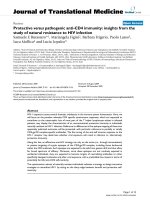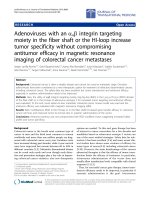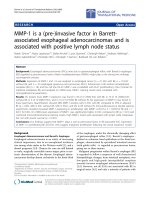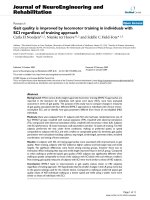báo cáo hóa học:" HIV prevention is not enough: child survival in the context of prevention of mother to child HIV transmission" potx
Bạn đang xem bản rút gọn của tài liệu. Xem và tải ngay bản đầy đủ của tài liệu tại đây (911.55 KB, 10 trang )
BioMed Central
Page 1 of 10
(page number not for citation purposes)
Journal of the International AIDS
Society
Open Access
Commentary
HIV prevention is not enough: child survival in the context of
prevention of mother to child HIV transmission
Louise Kuhn*
1
, Moses Sinkala
2
, DonMThea
3
, Chipepo Kankasa
4
and
Grace M Aldrovandi
5
Address:
1
Gertrude H. Sergievsky Center, and Department of Epidemiology, Mailman School of Public Health, Columbia University, New York,
NY, USA,
2
Catholic Medical Mission, Lusaka, Zambia,
3
Center for International Health & Development, Boston University School of Public
Health, Boston, MA, USA,
4
University Teaching Hospital, University of Zambia, Lusaka, Zambia and
5
Children's Hospital Los Angeles, University
of Southern California, Los Angeles, CA, USA
Email: Louise Kuhn* - ; Moses Sinkala - ; Don M Thea - ;
Chipepo Kankasa - ; Grace M Aldrovandi -
* Corresponding author
Abstract
Clinical and epidemiologic research has identified increasingly effective interventions to reduce
mother to child HIV transmission in resource-limited settings These scientific breakthroughs have
been implemented in some programmes, although much remains to be done to improve coverage
and quality of these programmes. But prevention of HIV transmission is not enough. It is necessary
also to consider ways to improve maternal health and protect child survival.
A win-win approach is to ensure that all pregnant and lactating women with CD4 counts of <350
cells/mm
3
have access to antiretroviral therapy. On its own, this approach will substantially improve
maternal health and markedly reduce mother to child HIV transmission during pregnancy and
delivery and through breastfeeding. This approach can be combined with additional interventions
for women with higher CD4 counts, either extended prophylaxis to infants or extended regimens
of antiretroviral drugs to women, to reduce transmission even further.
Attempts to encourage women to abstain from all breastfeeding or to shorten the optimal duration
of breastfeeding have led to increases in mortality among both uninfected and infected children. A
better approach is to support breastfeeding while strengthening programmes to provide
antiretroviral therapy for pregnant and lactating women who need it and offering antiretroviral
drug interventions through the duration of breastfeeding. This will lead to reduced HIV
transmission and will protect the health of women without compromising the health and well-being
of infants and young children.
Introduction
The field of prevention of mother to child HIV transmis-
sion (PMTCT) has given us some of the biggest break-
throughs and achievements in the field of HIV prevention
research. Notably, clinical and epidemiologic research in
this field established that antiretroviral drugs are effective
agents of HIV prevention. This field has also given us
some the most heartbreaking disappointments and
missed opportunities for resource-poor areas. Prominent
among these are the increased child mortality among
Published: 11 December 2009
Journal of the International AIDS Society 2009, 12:36 doi:10.1186/1758-2652-12-36
Received: 11 September 2009
Accepted: 11 December 2009
This article is available from: />© 2009 Kuhn et al; licensee BioMed Central Ltd.
This is an Open Access article distributed under the terms of the Creative Commons Attribution License ( />),
which permits unrestricted use, distribution, and reproduction in any medium, provided the original work is properly cited.
Journal of the International AIDS Society 2009, 12:36 />Page 2 of 10
(page number not for citation purposes)
both infected and uninfected infants that has resulted
from encouraging HIV-infected women to shorten the
duration or abstain from all breastfeeding. Missed oppor-
tunities include the failures to implement widely effective
antiretroviral and counselling interventions. Recent find-
ings provide important new evidence to policymakers in
crafting sound programmes for PMTCT and infant feed-
ing.
Prevention of HIV transmission is not enough. It is neces-
sary also to consider ways to improve maternal health and
protect child survival. In this report, we review the availa-
ble data and conclude that the key to future success in
most resource-limited settings is to provide counselling
and support for breastfeeding while strengthening pro-
grammes that provide antiretroviral therapy for pregnant
and lactating women who need it and offering antiretro-
viral drug interventions throughout the duration of
breastfeeding. This will lead to reduced HIV transmission
and will protect the health of women without compro-
mising the health and well-being of infants and young
children.
Discussion
Discovery that antiretroviral drugs are effective agents of
HIV prevention
The field of PMTCT can be credited with what is perhaps
the biggest breakthrough in HIV prevention research. Fif-
teen years ago, clinician-scientists in the US and France
demonstrated that zidovudine alone could reduce mother
to child transmission of HIV from 25% to 8% in a non-
breastfeeding population [1]. The use of antiretroviral
drugs to prevent HIV transmission was controversial at the
time, but the results were compelling. However, it was not
clear how the complex and expensive regimen tested in
the first trial could be made applicable to the health care
circumstances in sub-Saharan Africa, where it was needed
most.
Through the dedication and determination of investiga-
tors in the field, the successes of PMTCT research contin-
ued. Through well-coordinated and collaborative trials,
breakthroughs continued, and studies in west Africa and
Thailand demonstrated that short courses of oral zidovu-
dine were effective in reducing transmission [2,3]. A land-
mark study in Uganda demonstrated that single-dose
nevirapine was effective in reducing mother to child HIV
transmission [4]. These two findings provided the first
proof that feasible and effective antiretroviral prophylaxis
could be implemented in developing areas, where health
system resources were highly limited.
Active research in this area produced continued refine-
ments in prophylactic antiretroviral drug regimens. Stud-
ies in Malawi and South Africa demonstrated how post-
partum prophylaxis could be effective for the large
number of infants whose mothers had not accessed opti-
mal antenatal care [5,6]. A pivotal study in Thailand was
particularly useful in demonstrating the improved out-
comes with combination zidovudine and nevirapine
prophylaxis [7]. With the remarkable increases in access to
effective HIV treatment among adults in many African
countries, studies began to clarify how best to integrate
adult treatment and PMTCT activities [8]. Recently, two
important studies demonstrated that using extended
infant prophylaxis could reduce transmission through
breastfeeding [9,10].
Opportunities to implement PMTCT taken and missed
The demonstration that effective PMTCT is achievable has
inspired civil society. Demands for programmes to pro-
vide access to antiretroviral drugs to prevent transmission
to infants mobilized community organizations and the
medical community in South Africa in 2001, resulting in
the establishment of a national PMTCT programme. But
investigators in this field have also been targets of attack
and have borne the brunt of unfair accusations about poi-
soning babies and neglecting women. It has taken great
courage to move these results into programmes.
In part through strong support from the international
community, PMTCT has now been implemented in
almost every African country [11]. There have been several
sites with creative methods to adapt the interventions to
be appropriate to the specific health service needs [12].
For example, in rural Uganda, a special pre-packaged for-
mulation of the infant nevirapine dose was used to ensure
that women who delivered at home could give their
infants the nevirapine [13]. In Zambia, establishment of
rigorous data management systems and careful analysis of
routine data has allowed on-going strengthening of pro-
grammes to improve coverage and quality [14,15]. Imple-
mentation of PMTCT also helped leverage resources for
HIV treatment programmes and has provided a platform
to help treatment programmes get started.
Despite these encouraging successes, major gaps in
PMTCT implementation exist. We are a long way from
widespread implementation of interventions shown to be
effective in clinical trials. Equitable and universal coverage
is lacking in most countries. The global average is esti-
mated to be that about 45% of women who need PMTCT
have access to it [16], and this is highly skewed towards
women living in certain urban areas. There is weak or
non-existent coordination between PMTCT and adult
treatment programmes in many places, and both continu-
ity of care and follow up is very often poor. Quality of
counselling, particularly as it relates to infant feeding, is of
poor quality and often confused [17].
Journal of the International AIDS Society 2009, 12:36 />Page 3 of 10
(page number not for citation purposes)
So, despite successful and clinically relevant PMTCT
research, the human toll of infection among women of
child-bearing age and among children remains high. The
human toll is mostly borne by the young mothers with
HIV who have to grapple with the terrible fear of transmit-
ting HIV to their infants. A mother living in Soweto partic-
ipating in an early infant diagnosis programme typifies
the dilemma: "I told myself that just like in soccer I
should prepare myself to either win or lose, positive or
negative." [18] This mother teaches us that despite the for-
midable opponent of HIV, we should not give up hope.
Making sense of the numbers: denominators matter
In the absence of any interventions, about a third of
infants born to HIV-infected mothers acquire HIV infec-
tion. About 20% of infants born to HIV-infected mothers
acquire HIV during pregnancy or delivery, usually referred
to intrauterine and intrapartum transmission (or together
as perinatal transmission) [19]. Approximately 14% of
infants who are breastfed for the typical duration of 18
months will acquire HIV through breastfeeding [20].
These rates, which use the number of infants born to HIV-
infected mothers as the denominator, have been known
since the late 1980s and have been confirmed with more
sophisticated study designs and with the latest HIV diag-
nostic methods [21,22].
If we re-express these rates using the number of infected
children as the denominator, breastfeeding accounts for
about 40% of all infant infections (Figure 1A). Careful
epidemiologic studies over many years have identified
several risk factors for transmission, the strongest of which
are maternal CD4 count and viral load. Additionally, it
has now been firmly established that breast milk trans-
mission is substantially enhanced by the amount of virus
in breast milk, and the quality and duration of breastfeed-
ing [23,24]. Susceptibility factors, including innate and
acquired immune responses in the child, in the mother
and in breast milk, protect against HIV transmission
[25,26].
Antiretroviral interventions given only during pregnancy
and peri-partum reduce transmission occurring during
pregnancy and delivery, and largely leave postnatal trans-
mission untouched. While there may be some short-term
benefits for early postnatal HIV transmission of some
peri-partum antiretroviral drug interventions [27], they
have only minor impact on transmission occurring
throughout the full duration of breastfeeding.
For the purpose of illustration, consider the implementa-
tion of antiretroviral intervention that reduces intrauter-
ine and intrapartum transmission to 8%. Assuming
breastfeeding transmission risk is unaffected, an addi-
tional 14% acquire infection postnatally, bringing the
total transmission rate to 22%. In this scenario, postnatal
transmission now constitutes 64% of all infections, even
though the total number of infections has shrunk. Many
highlight the 64% statistic to emphasize the importance
of postnatal transmission. But it is easy to misinterpret
these numbers because of shifting denominators.
Transmission rates are expressed as the number of
infected infants divided by the number of infants born to
HIV-infected mothers. However, it is important to empha-
size that the 64% statistic includes a different, more lim-
ited denominator - only infected infants born to HIV-
infected mothers (Figure 1B). This distinction becomes
essential to understand for health education, where mes-
sages about the actual magnitude of postnatal HIV trans-
mission may become exaggerated.
Breakthroughs in preventing HIV transmission through
breastfeeding
It is an unfortunate reality that breakthroughs in confirm-
ing interventions to reduce HIV transmission through
breastfeeding have been made only relatively recently. As
result, the 14% or 64% [sic] postnatal HIV transmission
rates remain unmodified in most education and training
materials for PMTCT programmes. Thus the information
that is provided is out of date and fuels the fear of women
and counsellors (and often policy makers) about breast-
feeding.
There have, however, been three crucial breakthroughs in
understanding how to prevent postnatal HIV transmis-
sion that now confirm that it is possible to reduce postna-
tal HIV transmission to ~1%. These effective interventions
include: (1) lactation counselling and support; (2) use of
triple antiretroviral drug regimens for women that are
either continued life-long as therapy or continued
through breastfeeding as prophylaxis; and (3) extended
regimens of antiretroviral prophylaxis to the infant.
Lactation counselling and support
The new millennium brought remarkable new insights
from the Durban group, demonstrating that the quality of
breastfeeding practices affects postnatal HIV transmission
[24,28]. It showed that the risk of postnatal HIV transmis-
sion was reduced among women who breastfed their
infants only breast milk and nothing else (exclusive
breastfeeding) to three months, and was higher among
women who introduced other foods and liquids earlier
than three months while continuing to breastfeed [24,28].
The benefits of exclusive breastfeeding in reducing postna-
tal transmission have subsequently been confirmed, and
refined, in at least four other large studies [29-32]. The
biological basis of this association remains unknown and
is likely to be multi-factorial [33].
Journal of the International AIDS Society 2009, 12:36 />Page 4 of 10
(page number not for citation purposes)
Transmission rates and proportions of infectionsFigure 1
Transmission rates and proportions of infections. Panel A - Transmission rates and proportions of infections due to
transmission through different routes among breastfed infants born to HIV-infected mothers if no interventions are provided.
Panel B - Transmission rates and proportions of infections among breastfed infants born to HIV-infected mothers when short
course antiretroviral interventions are provided.
%
%
41%
&
%
A
%
%
64%
&
%
B
Journal of the International AIDS Society 2009, 12:36 />Page 5 of 10
(page number not for citation purposes)
The powerful insight provided by these observations is
that a simple behavioural intervention of improving
breastfeeding quality is as effective in reducing HIV trans-
mission as the short-course antiretroviral drug regimens
used for PMTCT. This is not to say that counselling should
replace antiretroviral interventions. Rather, they are com-
plementary interventions that should be implemented
together. The benefits of lactation management and sup-
port extend beyond reductions in HIV transmission.
Exclusive breastfeeding is best for all infants, regardless of
their HIV status, and is associated with decreased infant
mortality [34]. Another advantage of lactation counsel-
ling is that simple and consistent infant feeding messages
can be given to both HIV-positive and HIV-negative
women.
Therapeutic antiretroviral regimens for the mother
Treating pregnant women with combination antiretrovi-
ral drugs is highly effective in reducing vertical HIV trans-
mission, including transmission through breastfeeding
[35-39]. There are a number of ways in which antiretrovi-
ral therapy can be used. Standard treatment regimens can
simply be given to all HIV-infected pregnant women,
regardless of their clinical stage or CD4 count. This is an
attractive approach for its simplicity, and it has been
shown to be effective [35-39].
Another approach is to optimize the regimens to avoid
toxicity and drug-resistance problems. Important new
results showing the benefit of this approach from Bot-
swana were recently presented [40]. A highly attractive
approach is one based on rational integration of adult
HIV treatment with PMTCT programmes [41]. In this
approach, HIV treatment is provided only to women who
need it for their own health. The effectiveness of this
approach was demonstrated in the MTCT-Plus pro-
gramme in Cote d'Ivoire [8]. This is a win-win interven-
tion that treats the mother while preventing transmission.
It is important to understand why rational integration of
adult HIV treatment programmes and PMTCT is so effec-
tive to reduce postnatal transmission through breastfeed-
ing. It is clearly established that CD4 counts are a very
strong predictor of postnatal transmission: the lower the
CD4 count, the higher the transmission. In our study in
Zambia [42], the postnatal HIV transmission rate through
breastfeeding was 20% in women with CD4 counts of
<350 cells/mm
3
and around 4% in women with CD4
counts above 350.
Combining these two populations together yields the esti-
mate of ~12%, usually quoted as the risk of postnatal HIV
transmission through breastfeeding. Marked differences
in the distribution of CD4 counts across study popula-
tions also explain why studies utilizing similar interven-
tions may report such different transmission rates. With
the distribution of CD4 count observed in our cohort in
Zambia, more than 80% of all postnatal infections
occurred among women with CD4 counts of <350 (Figure
2A).
If antiretroviral treatment is provided to all pregnant
women with CD4 counts below 350, the available data
indicate that postnatal transmission will be reduced to 1-
2%. Even if no additional postnatal interventions are pro-
vided for women with higher CD4 counts, the transmis-
sion rate in the population as a whole will still decline to
<5% (Figure 2B).
Extended regimens of antiretroviral prophylaxis to the infant
It is possible to reduce the transmission rate even further
by providing additional interventions for those women
with higher CD4 counts who do not need antiretroviral
therapy for their own health. Two new studies from
Malawi have shown that extended prophylaxis with nevi-
rapine to the infant substantially reduce postnatal trans-
mission through breastfeeding. In the first study,
prophylaxis was used for only 14 weeks [10]. In the sec-
ond study, prophylaxis was used for six months and was
as effective as triple antiretroviral drug regimens given to
the mother as prophylaxis in reducing postnatal transmis-
sion [43]. It will be important to investigate whether
prophylaxis can be extended further to cover the normal
duration of breastfeeding.
Dark clouds of deteriorating infant feeding practices
Despite these important scientific breakthroughs, there is
unfortunately a dark cloud. And this dark cloud is pro-
vided by the shifts in infant feeding practices that have
occurred in many places, inspired by the fear of HIV trans-
mission. In many places, HIV-infected women in commu-
nities that previously had good uptake of full
breastfeeding have shifted away from breastfeeding or
have opted to wean their infants much earlier than they
usually would have.
In sobering new data from rural Rakai, Uganda, mortality
among infants born to HIV-infected mothers who elected
to abstain from all breastfeeding was increased six-fold
compared with infants born to mothers who elected to
breastfeed [44]. In a clinical trial in Botswana, mortality
among uninfected infants born to HIV-infected mothers
was doubled among those randomized to abstain from
breastfeeding compared with those randomized to short
breastfeeding [45]. These two reports together suggest that
the excess mortality due to replacement feeding is higher
in programmatic than in clinical trial settings.
However, even in a clinical trial conducted in a country
with more resources and where reasonable efforts were
Journal of the International AIDS Society 2009, 12:36 />Page 6 of 10
(page number not for citation purposes)
Why treating only women with low CD4 counts reduces postnatal HIV transmissionFigure 2
Why treating only women with low CD4 counts reduces postnatal HIV transmission. Panel A - Postnatal HIV
transmission rates in the population are an average of low rates among women with high CD4 counts and high rates among
women with low CD4 counts. Panel B - When antiretroviral therapy is given to women with low CD4 counts, the postnatal
HIV transmission rate in this group, and in the overall population, declines to low levels.
CD4 <350
CD4 >350
Population of pregnant HIV+ women
20%
4%
12%
84% of postnatal
transmissions
A
CD4 <350
CD4 >350
Population of pregnant HIV+ women
2%
4%
3%
Therapy given if
CD4 <350
CD4 <350 and given therapy
B
Journal of the International AIDS Society 2009, 12:36 />Page 7 of 10
(page number not for citation purposes)
made to provide appropriate measures for "safe" formula
feeding, a two-fold increase in uninfected child mortality
was reported [45]. HIV researchers have now learned the
same lessons as studies in the 1960s and 1970s that dem-
onstrated that shifts away from breastfeeding increases
infant mortality [46].
Is "no benefit" equal to "no harm"?
In the Botswana trial, mortality among uninfected infants
less than six months of age was increased about two-fold
among those whose mothers were randomized to abstain
from breastfeeding compared with those randomized to
breastfeed. But abstinence from breastfeeding was able to
reduce HIV transmission. Sadly, adding together these
competing risks, there is no net benefit in terms of HIV-free
survival of abstinence from breastfeeding [45].
We have recently completed a clinical trial in Lusaka,
Zambia, which examined the period of four to 24 months
in greater detail. We, like the Botswana group, also
reported no net benefit of shortening the usual duration of
breastfeeding on HIV-free survival [42]. When we investi-
gated why we observed no benefit of early cessation of
breastfeeding by examining what the women in the inter-
vention and control groups actually did, we found that the
risk of uninfected child mortality to 24 months was
increased about three-fold if women stopped breastfeed-
ing early compared with breastfeeding for 18 months or
longer [47]. Stopping breastfeeding earlier than normal
did reduce transmission. In other words, the benefit of
HIV prevented was canceled out by the harm of unin-
fected child deaths caused by other infectious diseases
(Figure 3).
These results are not reassuring about the safety of absti-
nence from breastfeeding or early weaning. To the con-
trary, "no benefit" does not mean the same thing as "no
harm". A key point is that both of these examples are in
the absence of effective antiretroviral regimens. When we
provide antiretroviral drugs (using almost any of the
approaches described above), postnatal transmission is
substantially reduced.
Viewed in this context, the elevations in uninfected child
mortality caused by abstinence from breastfeeding or
caused by early weaning are no longer justified by HIV
prevention efforts. The numbers of HIV infections pre-
vented are now considerably less than the numbers of
replacement feeding-related deaths caused. When antiret-
roviral drugs are provided, what was previously "no bene-
fit" now becomes harm. This is not because the
antiretroviral drugs are harmful, but because in the deli-
cate risk-benefit balance, mortality caused by abstinence
from breastfeeding or shortening the duration of breast-
feeding is now greater than the amount of HIV prevented
(Figure 3).
This can be seen most clearly among women who have
high CD4 counts and do not meet criteria for antiretrovi-
ral treatment. This group of women is at lower risk of
transmitting even if no interventions are provided. As we
observed in our cohort in the Zambia Exclusive Breast-
feeding Study, for women with higher CD4 counts, there
were worse infant outcomes if breastfeeding was short-
ened. In this group, where the HIV transmission rate is
lower, the risks of prematurely truncating breastfeeding
outweigh any benefits to prevent transmission [47] (Fig-
ure 4).
Should we burn down the forest to save the trees?
In the quest for eliminating HIV transmission, we need to
be cautious of the steps we take to get there. We can save
the child from HIV, but have to be careful that we do not
increase their risk of dying from other diseases. HIV pre-
Balancing adverse outcomes in breastfed and non-breastfed infantsFigure 3
Balancing adverse outcomes in breastfed and non-
breastfed infants. Panel A - When effective antiretroviral
drugs are not provided, abstinence from breastfeeding or
early weaning may result in no benefit for HIV-free survival,
i.e., number of extra uninfected deaths caused = number of
HIV infections prevented. Panel B - When effective antiretro-
viral drugs are provided, abstinence from breastfeeding or
early weaning results in worse outcomes, i.e., number of
extra uninfected deaths (in black outline) caused > number of
HIV infections (in red outline) prevented.
Journal of the International AIDS Society 2009, 12:36 />Page 8 of 10
(page number not for citation purposes)
vention is not enough: the goal should be healthy chil-
dren. The integration of adult HIV treatment with PMTCT
has shown that it is possible to address both maternal
health and prevent mother to child transmission. We
should now turn to integrating these activities with pro-
grammes to protect child survival.
Integrating PMTCT and child survival
The HIV-exposed uninfected child living in environments
where HIV is the most prevalent is at risk for many dis-
eases, not only HIV. We add to the jeopardy of this child
by some of the interventions we provide as part of PMTCT
programmes. This jeopardy is increased with a single-
minded focus only on HIV prevention without considera-
tion of broader inventions that improve infant health and
development.
The unprecedented resources that have been made availa-
ble to address HIV have overshadowed the resources avail-
able for routine child survival. Many simple interventions
known to be of benefit to high-risk children in low-
resource settings are not being implemented, perhaps
because they do not have the cache and the advocates that
HIV prevention has. The HIV-exposed uninfected child is
also different to all other uninfected children because his
or her mother is HIV positive. This has profound social
ramifications of stigma, familial loss and deterioration of
maternal health, all of which may affect the well-being of
the uninfected children [48].
It also appears that there might be biological deficits asso-
ciated with having been exposed to HIV [49]. Those who
look for correlates of protective immunity in the natural
context have written of the immunologic advantage
among those lucky enough to have escaped HIV infection
[25,26]. But there may be an immunologic disadvantage
that makes exposed, uninfected infants more vulnerable
to other diseases [48]. We are yet to properly understand
what the long-term clinical consequences are for the hun-
dreds of thousands of children exposed to HIV, but who
survive uninfected.
Conclusion
The PMTCT field can be credited with some of the most
important breakthroughs in HIV prevention research. We
have much to celebrate, but there are many challenges
ahead. HIV treatment and PMTCT programmes should
not be implemented as distinct and competing pro-
grammes, but can and should work hand in hand so that
maternal health is addressed alongside prevention of HIV.
The first priority should be to provide access to HIV treat-
ment for all pregnant and lactating women with CD4
counts of <350 cells/mm
3
. Every effort should be put into
programmes to ensure that this happens. For children
born to mothers with higher CD4 counts, there are several
options, either extended maternal regimens or infant
prophylaxis. Both work to prevent transmission. But this
is not enough.
These programmes also need to link with child survival
programmes, including high-quality counselling to sup-
port lactation, so that prevention of HIV can occur in a
context that ensures the health and well-being of children.
Competing interests
The authors declare that they have no competing interests.
Authors' contributions
LK wrote the first draft. All other authors revised the man-
uscript for critical content.
Acknowledgements
We would like to thank our collaborators and friends who have helped us:
Drs Lynne Mofenson, Kevin Ryan, Elaine Abrams, Zena Stein, Stephen
Arpadi, Jeffrey Stringer, Sten Vermund, Marc Bulterys, Prisca Kasonde,
Cheswa Vwalika, Mwiya Mwiya, Chewe Luo, Elwyn Chomba, Ellen Piwoz,
Anna Coutsoudis, Jerry Coovadia, Nigel Rollins, Ruth Bland, Glenda Gray,
Tammy Meyers, Ashraf Coovadia and Caroline Tiemessen. We thank the
National Institutes of Child Health and Human Development for financial
support.
References
1. Connor EM, Sperling RS, Gelber R, Kiselev P, Scott G, O'Sullivan MJ,
VanDyke R, Bey M, Shearer W, Jacobson RL, O'Neill E, Bazin B, Del-
fraissy J-F, Culnane M, Coombs R, Elkins M, Moye J, Stratton P, Balsey
J, for The Pediatric AIDS Clinical Trials Group Protocol 076 Study
Group: Reduction of maternal-infant transmission of human
immunodeficiency virus type 1 with zidovudine treatment.
N Engl J Med 1994, 331:1173-80.
2. Dabis F, Msellati A, Meda N, Welffens-Ekra C, You B, Manigart O,
Leroy V, Simonon A, Cartoux M, Combe P, Ouangré A, Ramon R, Ky-
Zerbo O, Montcho C, Salamon R, Rouzioux C, Perre P Van de, Man-
HIV-free survival by breastfeeding practiceFigure 4
HIV-free survival by breastfeeding practice. HIV-free
survival of children born to HIV-infected women with CD4
counts >350 is better if breastfeeding continues than if
breastfeeding stops early [47].
Continued BF
Stopped BF <
4 m
Journal of the International AIDS Society 2009, 12:36 />Page 9 of 10
(page number not for citation purposes)
delbrot L: 6-month efficacy, tolerance, and acceptability of a
short regimen of oral zidovudine to reduce vertical trans-
mission of HIV in breast fed children in Côte d'Ivoire and
Burkina Faso: a double-blind placebo-controlled mutlicentre
trial. Lancet 1999, 353:786-92.
3. Shaffer N, Chuachoowong R, Mock PA, Bhadrakom C, Siriwasin W,
Young NL, Chotpitayasunondh T, Cherskul S, Roongpisuthipong A,
Chinayon P, Karon J, Mastro TD, Simonds RJ, on behalf of the Bang-
kok Collaborative Perinatal HIV Transmission Study Group: Short-
course zidovudine for perinatal HIV-1 transmission in Bang-
kok, Thailand: a randomized controlled trial. Lancet 1999,
353:773-80.
4. Guay LA, Musoke P, Fleming T, Bagenda D, Allen M, Nakabiito C,
Sherman J, Bakaki P, Ducar C, Deseyve M, Emel L, Mirochnick M,
Fowler MG, Mofenson L, Miotti PG, Dransfield K, Bray D, Mmiro F,
Jackson B: Intrapartum and neonatal single-dose nevirapine
compared with zidovudine for prevention of mother-to-child
transmission of HIV-1 in Kampala, Uganda: HIVNET 012
randomised trial. Lancet 1999, 354:795-802.
5. Taha TE, Kumwenda NI, Hoover DR, Fiscus SA, Kafulafula G,
Nkhoma C, Nour S, Chen S, Liomba G, Miotti P, Broadhead RL: Nev-
irapine and zidovudine at birth to reduce perinatal transmis-
sion of HIV in an African setting: a randomized controlled
trial. JAMA 2004, 292:202-9.
6. Gray GE, Urban M, Chersich MF, Bolton C, van Niekerk R, Violari A,
Stevens W, McIntyre JA, for the PEP Study Group: A randomized
trial of two postexposure prophylaxis regimens to reduce
mother-to-child HIV-1 transmission in infants of untreated
mothers. AIDS 2005, 19:1289-97.
7. Lallemant M, Jourdain G, Le CS, Mary JY, Ngo-Giang-Huong N, Koet-
sawang S, Kanshana S, McIntosh K, Thaineua V, Perinatal HIV Preven-
tion Trial (Thailand) Investigators: Single-dose perinatal
nevirapine plus standard zidovudine to prevent mother-to-
child transmission of HIV-1 in Thailand. N Engl J Med 2004,
351:217-28.
8. Tonwe-Gold B, Ekouevi DK, Viho I, mani-Bosse C, Toure S, Coffie
PA, Rouet F, Becquet R, Leroy V, El-Sadr WM, Abrams EJ, Dabis F:
Antiretroviral treatment and prevention of peripartum and
postnatal HIV transmission in West Africa: evaluation of a
two-tiered approach. PLOS Medicine 2007, 4:e257.
9. Six Week Extended-Dose Nevirapine (SWEN) Study Team:
Extended-dose nevirapine to 6 weeks of age for infants to
prevent HIV transmission via breastfeeding in Ethiopia,
India, and Uganda: an analysis of three randomised control-
led trials. Lancet 2008, 372:300-13.
10. Kumwenda NI, Hoover DR, Mofenson LM, Thigpen M, Kafulafula G,
Li Q, Mipando L, Nkanaunena K, Mebrahtu T, Bulterys M, Fowler MG,
Taha TE: Extended antiretroviral prophylaxis to reduce
breast-milk HIV-1 transmission. N Engl J Med 2008, 359:119-29.
11. Spensley A, Sripipatana T, Turner A, Hoblitzelle C, Robinson J, Wil-
fert CM: Preventing mother-to-child transmission of HIV in
resource-limited settings: the Elizabeth Glaser Pediatric
AIDS Foundation experience. Am J Public Health 2009, 99:631-7.
12. Welty TK, Bulterys M, Welty ER, Tih PM, Ndikintum G, Nkuoh G,
Nkfusai J, Kayita J, Nkengasong JN, Wilfert CM: Integrating pre-
vention of mother-to-child HIV transmission into routine
antenatal care: the key to program expansion in Cameroon.
J Acquir Immun Defic Syndr 2005, 40:486-93.
13. Kagaayi J, Dreyfuss ML, Kigozi G, Chen MZ, Wabwire-Mangen F, Ser-
wadda D, Wawer MJ, Sewankambo N, Nalugoda F, Kiwanuka N, Kid-
dugavu M, Gray RH: Maternal self-medication and provision of
nevirapine to newborns by women in Rakai, Uganda. J Acquir
Immun Defic Syndr 2005, 39:121-4.
14. Stringer JS, Sinkala M, Maclean CC, Levy J, Kankasa C, Degroot A,
Stringer EM, Acosta EP, Goldenberg RL, Vermund SH: Effectiveness
of a city-wide program to prevent mother-to-child HIV
transmission in Lusaka, Zambia. AIDS 2005, 19:1309-15.
15. Stringer JS, Sinkala M, Goldenberg R, Vermund S, Acosta E: Monitor-
ing nevirapine-based programmes for prevention of mother-
to-child transmission of HIV-1. Lancet 2003, 362:667.
16. World Health Organization: Towards universal access: scaling
up priority HIV/AIDS interventions in the health sector:
Progress report 2009. WHO, Geneva; 2009.
17. Chopra M, Rollins N: Infant feeding in the time of HIV: rapid
assessment of infant feeding policy and programmes in four
African countries scaling up prevention of mother to child
transmission programmes. Arch Dis Child 2008, 93:288-91.
18. Lazarus R, Struthers H, Violari A: Hopes, fears, knowledge and
misunderstandings: responses of HIV-positive mothers to
early knowledge of the status of their baby. AIDS Care
2009,
21:329-34.
19. De Cock KM, Fowler MG, Mercier E, de Vincenzi I, Saba J, Hoff E, Aln-
wick DJ, Rogers M, Shaffer N: Prevention of mother-to-child
HIV transmission in resource-poor countries: translating
research into policy and practice. JAMA 2000, 283:1175-82.
20. Dunn DT, Newell ML, Ades AE, Peckham CS: Risk of human
immunodeficiency virus type 1 transmission through breast-
feeding. Lancet 1992, 340:585-8.
21. Nduati R, John G, Mbori-Ngacha D, Richardson B, Overbaugh J,
Mwatha A, Ndinya-Achola J, Bwayo J, Onyango F, Hughes J, Kreiss J:
Effect of breastfeeding and formula feeding on transmission
of HIV-1: A randomized clinical trial. JAMA 2000, 283:1167-74.
22. Breastfeeding and HIV International Transmission Study Group: Late
postnatal transmission of HIV-1 in breast-fed children: an
individual patient data meta-analysis. J Infect Dis 2004,
189:2154-66.
23. Rousseau CM, Nduati RW, Richardson BA, Steele MS, John-Stewart
GC, Mbori-Ngacha DA, Kreiss JK, Overbaugh J: Longitudinal anal-
ysis of human immunodeficiency virus type 1 RNA in breast
milk and of its relationship to infant infection and maternal
disease. J Infect Dis 2003, 187:741-7.
24. Coutsoudis A, Pillay K, Spooner E, Kuhn L, Coovadia HM: Influence
of infant feeding patterns on early mother-to-child transmis-
sion of HIV-1 in Durban, South Africa. Lancet 1999, 354:471-6.
25. Farquhar C, John-Stewart G: The role of infant immune
responses and genetic factors in preventing HIV-1 acquisi-
tion and disease progression. Clin Exp Immunol 2003, 134:367-77.
26. Kuhn L, Meddows-Taylor S, Gray G, Tiemessen C: Human immu-
nodeficiency virus (HIV)-specific cellular immune responses
in newborns exposed to HIV in utero. Clin Infect Dis 2002,
34:267-76.
27. Chung MH, Kiarie JN, Richardson BA, Lehman DA, Overbaugh J,
John-Stewart GC: Breast milk HIV-1 suppression and
decreased transmission: a randomized trial comparing
HIVNET 012 nevirapine versus short-course zidovudine.
AIDS 2005, 19:1415-22.
28. Coutsoudis A, Pillay K, Kuhn L, Spooner E, Tsai WY, Coovadia HM:
Method of feeding and transmission of HIV-1 from mothers
to children by 15 months of age: prospective cohort study
from Durban, South Africa. AIDS 2001, 15:379-87.
29. Iliff P, Piwoz E, Tavengwa N, Zunguza C, Marinda E, Nathoo K,
Moulton L, Ward B, Humphrey J: Early exclusive breastfeeding
reduces the risk of postnatal HIV-1 transmission and
increases HIV-free survival. AIDS 2005, 19:699-708.
30. Kuhn L, Sinkala M, Kankasa C, Semrau K, Kasonde P, Scott N, Mwiya
M, Vwalika C, Walter J, Tsai WY, Aldrovandi G, Thea DM: High
Uptake of Exclusive Breastfeeding and Reduced Early Post-
natal HIV Transmission. PLOS ONE 2007, 2(12):-e1363.
doi:10.1371/journal.pone.0001363
31. Coovadia HM, Rollins NC, Bland RM, Little K, Coutsoudis A, Bennish
ML, Newell ML: Mother-to-child transmission of HIV-1 infec-
tion during exclusive breastfeeding in the first 6 months of
life: an intervention cohort study. Lancet 2007, 369:1107-16.
32. Becquet R, Ekouevi DK, Menan H, Amani-Bosse C, Bequet L, Viho I,
Dabis F, Timite-Konan M, Leroy V: Early mixed feeding and
breastfeeding beyond 6 months increase the risk of postnatal
HIV transmission: ANRS 1201/1202 Ditrame Plus, Abidjan,
Cote D'Ivore. Preventive Medicine 2008, 47:27-33.
33. Smith MM, Kuhn L: Exclusive breast-feeding: Does it have the
potential to reduce breast-feeding transmission of HIV-1?
Nutrition Reviews 2000, 58:333-40.
34. Lawrence R, Lawrence R: Breastfeeding: A guide for the medi-
cal professional. St Louis, Missouri: Mosby, Inc; 1999.
35. Thomas T, Masaba R, Ndivo R, Zeh C, Borkowf C, Thigpen M,
DeCock K, Amornkul P, Greenberg A, Fowler M, Kisumu Breasfeed-
ing Study Team: Prevention of Mother-to-Child Transmission
of HIV-1 among Breastfeeding Mothers Using HAART: The
Kisumu Breastfeeding Study, Kisumu, Kenya, 2003-2007.
15th Conference of Retrovirus and Opportunistic Infections Boston, USA
Feb 2008 2008. Abstract 45aLB
Publish with Bio Med Central and every
scientist can read your work free of charge
"BioMed Central will be the most significant development for
disseminating the results of biomedical research in our lifetime."
Sir Paul Nurse, Cancer Research UK
Your research papers will be:
available free of charge to the entire biomedical community
peer reviewed and published immediately upon acceptance
cited in PubMed and archived on PubMed Central
yours — you keep the copyright
Submit your manuscript here:
/>BioMedcentral
Journal of the International AIDS Society 2009, 12:36 />Page 10 of 10
(page number not for citation purposes)
36. Kesho Bora Study Group: Triple-antiretroviral prophylaxis dur-
ing pregnancy and breastfeeding compared to short-ARV
prophylaxis to prevent mother-to-chil transmission of HIV-
1: the Kesho Bora randomized controlled trial in five sites in
Burkino Faso, Kenya and South Africa. Fifth International AIDS
Society Conference on HIV Treatment, Pathogenesis and Prevention, Cape
Town, abstract WeLBPeC01 2009.
37. Kilewo C, Karlsson K, Ngarina M, Massawe A, Lyamuya E, Swai A,
Lipyoga R, Mhalu F, Biberfeld G: Prevention of mother-to-child
transmission of HIV-1 through breastfeeding by treating
mothers with triple antiretroviral therapy in Dar es Salaam,
Tanzania: the Mitra Plus study. J Acquir Immune Defic Syndr 2009,
52:406-16.
38. Marazzi MC, Nielsen-Saines K, Buonomo E, Scarcella P, Germano P,
Majid NA, Zimba I, Ceffa S, Palombi L: Increased infant human
immunodeficiency virus-type one free survival at one year of
age in sub-saharan Africa with maternal use of highly active
antiretroviral therapy during breast-feeding. Pediatr Infect Dis
J 2009, 28:483-7.
39. Peltier CA, Ndayisaba GF, Lepage P, van GJ, Leroy V, Pharm CO,
Ndimubanzi PC, Courteille O, Arendt V: Breastfeeding with
maternal antiretroviral therapy or formula feeding to pre-
vent HIV postnatal mother-to-child transmission in Rwanda.
AIDS 2009, 23:2473-7.
40. Shapiro RL, Hughes M, Ogwu A: A randomized trial comparing
highly active antiretroviral therapy regimens for virologic
effiacy and the prevention of mother-to-child transmission
among breastfeeding women in Botswana (The Mma Bana
Study). 5th IAS Conference on HIV Pathogenesis, Treatment and Preven-
tion; WELBB 101: Cape Town-19-22 July 2009.
41. Myer L, Rabkin M, Abrams EJ, Rosenfield A, El Sadr W: Focus on
women: linking HIV care and treatment with reproductive
health services in the MTCT-Plus initiative. Reproductive Health
Matters 2005, 13:136-46.
42. Kuhn L, Aldrovandi GM, Sinkala M, Kankasa C, Semrau K, Mwiya M,
Kasonde P, Scott N, Vwalika C, Walter J, Bulterys M, Tsai WY, Thea
DM: Effects of early, abrupt cessation of breastfeeding on
HIV-free survival of children in Zambia. N Engl J Med 2008,
359:130-41.
43. Chasela C, Hudgens M, Jamieson DJ: Both maternal HAART and
daily infant nevirapine (NVP) are effective in reducing HIV-1
transmission during breastfeeding in a randomized trial in
Malawi: 28 week results of the Breastfeeding, Antiretroviral
and Nutrition (BAN) Study. 5th IAS Conference on HIV Pathogen-
esis, Treatment and Prevention; WELBC 103: Cape Town-19-22 July 2009.
44. Kagaayi J, Gray RH, Brahmbhatt H, Kigozi G, Nalugoda F, Wabwire-
Mangen F, Serwadda D, Sewankambo N, Ddungu V, Ssebagala D,
Sekasanvu J, Kigozi G, Makumbi F, Kiwanuka N, Lutalo T, Reynolds SJ,
Wawer MJ: Survival of infants born to HIV-positive mothers
by feeding modality in Rakai, Uganda. PLOS ONE 2008, 3:e3877.
45. Thior I, Lockman S, Smeaton LM, Shapiro RL, Wester C, Heymann SJ,
Gilbert PB, Stevens L, Peter T, Kim S, van Widenfelt E, Moffat C,
Ndase P, Arimi P, Kebaabetswe P, Mazonde P, Makhema J, McIntosh
K, Novitsky V, Lee TH, Marlink R, Lagakos S, Essex M, Mashi Study
Team: Breastfeeding plus infant zidovudine prophylaxis for 6
months vs formula feeding plus infant zidovudine for 1
month to reduce mother-to-child HIV transmission in Bot-
swana: a randomized trial: the Mashi Study. JAMA 2006,
296:794-805.
46. Jelliffe DB, Jelliffe EF: Human milk in the modern world. New
York: Oxford University Press; 1978.
47. Kuhn L, Aldrovandi GM, Sinkala M, Kankasa C, Semrau K, Kasonde P,
Mwiya M, Tsai WY, Thea DM: Differential effects of early wean-
ing for HIV-free survival of children born to HIV-infected
mothers by severity of maternal disease. PLOS ONE 2009,
4:e6059.
48. Filteau S: The HIV-exposed, uninfected African child. Tropical
Medicine & International Health 2009, 14:1-12.
49. Kuhn L, Thea DM, Aldrovandi GM: Bystander effects: children
who escape infection but not harm. Journal of Acquired Immune
Deficiency Syndromes 2007, 46:517-8.

